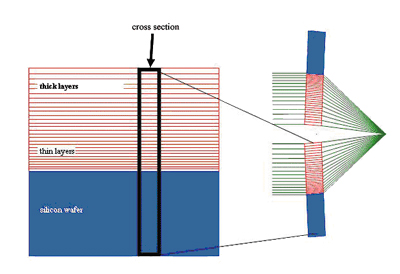FROM: Physics News Update
Number 773 #1, April 12, 2006, by Phil Schewe and Ben Stein
Note: This text has been slightly modified from the original.
Sharper focusing of hard x-rays has been achieved with a device developed at Argonne National Lab.
Because of their high energy, x-rays are hard to focus: they can be reflected from a surface but only at a glancing angle (less than a tenth of a degree); they can be refracted but the index of refraction is very close to 1, so that making efficient lenses becomes a problem; and they can be diffracted, but the relatively thick, variable pitch grating required for focusing is tricky to achieve.
The Argonne device is of the diffraction type, and it consists of a stack of alternating layers of metal and silicon, made by depositing progressively thicker layers. When the x-rays fall on such a structure, nearly edge-on, what they see is a grating (called a linear zone plate) consisting of a sort of bar-code pattern.
The Argonne device succeeds so well in focusing x-rays because the position of the zones can be controlled to within nanometer tolerances through the deposition process, and the depth of the zones that the x-rays experience can be made arbitrarily long (many microns long) by merely cutting a thicker section of the multilayer wafer. In tests so far, one of these zone plates, very slightly tilted to the x-rays coming out of a synchrotron source, has focused 20-kiloelectronvolt x-rays to a line only 30 nanometer wide, better than previously possible.
According to Argonne researcher Brian Stephenson, an ideal version of this kind of x-ray lens, which they call a Multilayer Laue Lens (MLL), should be able to focus x-rays to a spot of 1 nanometer or less. The likely use for a better x-ray lens is in scanning-probe microscopy (by scanning the beam across a sample).
See: H. C. Kang, J. Maser, G. B. Stephenson, C. Liu, R. Conley, A. T. Macrander, and S. Vogt, “Nanometer Linear Focusing of Hard X Rays by a Multilayer Laue Lens,” Phys. Rev. Lett. 96, 127401 (2006). Contact Brian Stephenson, [email protected], 630-252-3214
Credit: American Institute of Physics.
Work supported by the U. S. Department of Energy, Office of Science, Office of Basic Energy Sciences, under Contract No. W-31-109-ENG-38.

